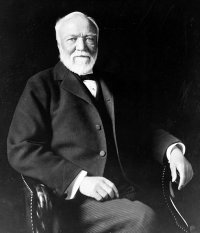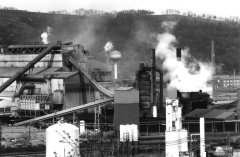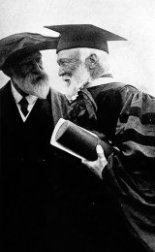|
"The American Steel Industry," Hosted By The Greatest Rags To Riches Legend Ever.
Carnegie Steel Ohio AboveIt's impossible to talk about the American steel industry without speaking about a man by the name of Andrew Carnegie. Just like it was impossible to talk about the steel industry existing, at all, throughout the world and not mention the name, “Henry Bessemer” Andrew was born in Scotland on November 25th 1835. He came to America with his parents and had absolutely no one to blame but himself for his huge success. Huge would actually be an understatement if you consider the fact that he is still known as the second richest man in history next to John D. Rockefeller. "From Rags To Riches" 
This man was the ultimate in rags to riches stories that you will ever hear. He started out as a factory worker and worked his way up to being a messenger boy. Did I mention that he worked his way “up” to being a messenger boy? However, people recognized his hard work and perseverance everywhere that he went. He managed to rub shoulders with the right people and they helped him along with proper investments, but again, that could not have happened if he was not who he was as a person. You will want to find time to read on him and his success.
He has an autobiography out that I’m sure that will enjoy. I have to skip over some of the details of his other dealings so that I can get to the ones that pertain to the American Steel Industry so bare with me.
"Andrews First Steel Mill" Before Andrew was in his 40’s he was on top of his game. In the 1870’s Carnegie constructed his first steel mill, Edgar Thomson Steel Works in Braddock, Pennsylvania. The profits made by the Edgar Thomson Steel Works allowed Carnegie and a number of his associates to purchase other nearby steel mills. He was mass-producing cheep and efficient steel rails for the railroads. The railroads were the first big businesses in America, and The Pennsylvania Railroad was one of the largest. He made use of his close connection to Thomson A. Scott of the Pennsylvania Railroad Company who had employed Carnegie as a telegraph operator at a salary of $4.00 per week when he was only 18. Like I said, he was the creator of his own success, but he managed to rub the right shoulders. By the 1880’s Carnegie was also the single largest manufacturer of pig iron, the intermediate product of smelting iron ore with coke. He was also the largest manufacturer of steel rails and coke in the entire world with a capacity of 2000 tons of pig metal per day. 
In 1888, Carnegie bought Homestead Steel Works, which included an extensive plant served by tributary coal and iron fields, a 425-mile (685 km) long railway, and a line of lake steamships. Carnegie combined his assets and those of his associates in 1892 to start Carnegie Steel Company. He was by far the leader in the American steel industry.
He never stopped moving forward. The American Steel industry had kept him busy for a good many years. He had created a number of other companies and grew his fortune. But when he was 66 it all seemed to be getting a bit tiring so he gave retirement a serious thought. In 1901 he decided to sell his share of his company to U.S. Steel. U.S. Steel is another company that I cannot mention the America steel industry and leave out. They had some big names that founded their company and I mean ones that you will also recognize as household names. I have to form another page to tell their story so click on the link when you are finished here to learn more. The buyout was the largest in the history of the United States.
Because of heavy debts taken on at the company's formation Carnegie insisted on being paid in gold bonds for his stake. He ended up giving most of his money away to establish libraries, schools, and universities. "He Earned It, And Gave It All Back" 
Carnegie spent his last years as a philanthropist. Carnegie bought Skibo Castle in Scotland, and made his home partly there and partly in New York. He was a huge supporter of the movement for spelling reform as a means of promoting the spread of the English language. Andrew represented the American dream. He was an immigrant from Scotland who came to America and became successful.
He had already given away $350,695,653, of his wealth, which in modern day is about 4.3 billion. At his death, his last $30,000,000 was given to foundations, charities, and to pensioners. He is buried at the Sleepy Hollow Cemetery in North Tarrytown, New York. People like Andrew Carnegie make a country great. His role in the American steel industry will be forever remembered by those that are engaged in American history. If you can hear me out there Andrew, we greatly appreciate all that you have done for our country as well as the American steel industry. It continues to bless all of us even today.
|









 I was born here and have a hard enough time but we do live in a different America than we used to. Carnegie died on 11 August 1919 in Lenox, Massachusetts of bronchial pneumonia.
I was born here and have a hard enough time but we do live in a different America than we used to. Carnegie died on 11 August 1919 in Lenox, Massachusetts of bronchial pneumonia. 